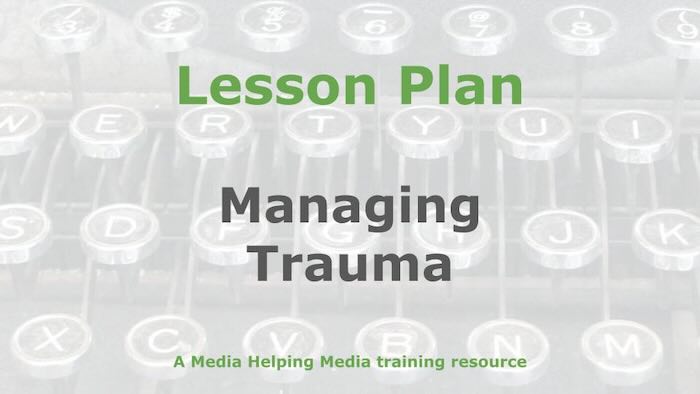
Journalists often witness challenging and traumatic events which can have a profound impact on the individual, their reporting, the victims, and the audience. We look at the help available for dealing with stress and trauma.
Whether covering natural disasters, conflicts, or personal tragedies, journalists are often exposed to stories that can affect their mental as well as physical well-being.
Recognising and addressing the potential for trauma and stress is crucial for maintaining both professional integrity and personal health.
The problem
In this piece we look at how journalists cope with the emotional, mental, and sometimes physical pressure. And how post traumatic stress disorder (PTSD) is increasingly affecting journalists and journalism.
The sheer volume of traumatic encounters within journalistic work means that many journalists experience work-related trauma. Some endure repeated, cumulative exposure, accumulating a lifetime of harrowing experiences.
For a long time, the notion that journalists could experience lasting harm from their reporting was dismissed. Their exposure to disturbing scenes and material was considered a routine occupational hazard, and they were expected to be emotionally robust.
This prevented journalists from openly discussing the potential effects of their work, as doing so was seen as a sign of weakness. Some journalists feared that admitting they had suffered trauma and stress would damage their careers and mean that they were no longer sent to cover the top stories. “Toughen up”, might have been a common response to a journalist voicing concerns about what they had seen and heard.
Causes of stress
Organisations such as the Dart Center for Journalism and Trauma challenged that concept. The study on the impact of trauma on journalists lists common events that can cause trauma and stress as:
- Automobile accidents
- Fires
- Executions
- Murders
- Mass casualties
- Wars
- Disasters
- Exposure to user generated content
Increased awareness
As awareness of PTSD in journalism increases, training is needed at the management, newsroom, and reporter level to help all involved in the newsgathering process understand the seriousness of the possible impact of trauma on the individual.
The challenge facing those training journalists is to:
- Make journalists aware that PTSD is a real thing and could happen to them.
- Help them identify in advance the kinds of situations that could lead to trauma.
- Teach them avoidance skills.
- Give them coping mechanisms for after the event.
- Encourage them to be compassionate and to recognise and help colleagues who are showing signs of PTSD.
- Educate all levels of newsroom management of the need to support and help colleagues who suffer from PTSD.
Guidelines
The UK’s National Union of Journalists (NUJ) has issued guidelines on the impact of PTSD on journalists.
The NUJ says that it isn’t just in conflict zones that media workers witness frightening images or deal with people experiencing traumatic events. Journalists can also be confronted with upsetting and dark situations watching footage on social media, covering a train crash or interviewing sexual abuse survivors.
Signs of stress
The Committee to Protect Journalists (CPJ) has a ‘security guide’ for journalists with the title ‘Covering the News in a dangerous and changing world’ where it looks at the signs of stress and how journalists can adopt coping mechanisms.
The CPJ says the signs are often subtle. A journalist may seem more anxious, irritable, withdrawn, numb, depressed, sad, or angry, and the emotions may be either sustained or fluctuating.
“Physical symptoms can include sleep or eating disorders, a rapid heartbeat, sweating, panic attacks, headaches, nausea, and chest pain. Strained personal and work relationships are often common. So is alcohol or drug abuse. Other signs may include an abnormally intense focus on one’s work, as if one is trying, as with other compulsive behaviours, to avoid uncomfortable feelings.”
Control measures
The BBC has set out guidelines for its journalistic staff when “covering events such as war, disasters and civil unrest“. The guidelines look at what could go wrong and set out control measures as well as what to look out for and what to do about it, including:
- Acknowledge what’s happened
- Sleep and eat well and take exercise
- Keep to routines where possible
- Talk it over with colleagues, a partner or a trusted friend if they are comfortable doing so
- If you’d rather not talk it may help to write down what you feel
- Take time for family and friends
- Take time to reflect
- Find things that make you laugh
- Take care with alcohol
- Ask for help and support
After the event
The International Federation of Journalists (IFJ) has published a 141-page ‘Survival Guide For Journalists’ in which chapter 6 focuses on PTSD. The document suggests that, as the name ‘post-traumatic’ suggests, problems often develop after the event:
- People who live through horrific events are all affected in some way, including journalists.
- Many have short-term reactions, which ease as they talk through issues with colleagues or family.
- Some need more help, often if feelings of helplessness and fear have been suppressed.
- About a quarter of journalists with extensive experience of conflict and war reporting suffer symptoms of PTSD.
- Changes are needed to the macho culture that makes journalists try to cope alone.
- Journalists should routinely debrief with trusted colleagues after hazardous assignments.
- There should be voluntary access to independent and knowledgeable counselling.
- Journalists with symptoms need an easy route to treatment.
- Journalists must be confident they will not suffer loss of position, opportunity or prestige.
- Local and freelance journalists are at risk of being left without support.
Distressing forms
This exposure to trauma manifests in diverse and distressing forms:
- Witnessing graphic scenes of accidents, violence, and disasters;
- Confronting disturbing user-generated content that often bypasses traditional editorial filters;
- Experiencing threats, harassment, and even physical violence;
- Engaging in the emotionally taxing work of fact-checking and interviewing trauma survivors.
These experiences can trigger a cascade of psychological impacts, from acute stress and anxiety to the debilitating effects of PTSD.
Symptoms
Symptoms such as flashbacks, nightmares, and hyper-vigilance can become a persistent burden, while trauma and moral and ethical issues erode a journalist’s sense of self and professional integrity.
- Vivid flashbacks. These are intense, realistic re-experiences of the traumatic event, as if it were happening again in the present moment, often accompanied by strong emotional and physical reactions.
- Intrusive thoughts or images. These are unwanted and distressing thoughts or mental pictures related to the trauma that repeatedly enter the mind, causing significant distress and disruption.
- Nightmares. These are disturbing dreams that often replay or symbolise the traumatic event, leading to sleep disturbances and increased anxiety upon waking.
- Constant anxiety. This involves a persistent feeling of worry, unease, or fear, often related to the trauma, that can significantly impact daily functioning and well-being.
- Physical sensations such as pain, sweating, nausea or trembling. These are symptoms that mirror the body’s response to the original trauma, re-experiencing the physical distress associated with the event.
- Alertness or feeling on edge. This hyper-vigilance involves a heightened state of awareness and reactivity to the environment, making the person feel constantly threatened or unsafe.
- Disturbed sleep or a lack of sleep. This insomnia or interrupted sleep patterns are common due to the intrusive thoughts and anxiety, preventing the person from achieving restful sleep.
- Finding it hard to concentrate. This cognitive impairment involves difficulty focusing, remembering, or making decisions, impacting the person’s ability to perform tasks and maintain attention.
It can often be some time after an event that a journalist experiences the symptoms of PTSD. Certain triggers can cause flashbacks. These triggers can be sensory experiences, such as sounds or smells, or emotional situations, that remind the individual of the traumatic event, thus setting off the symptoms.
The signs of trauma:
- Emotional symptoms:
- Intrusive thoughts and flashbacks.
- Persistent feelings of sadness, anger, or guilt.
- Emotional numbness or detachment.
- Increased anxiety and fear.
- Difficulty concentrating.
- Physical symptoms:
- Sleeplessness or nightmares.
- Physical reactions such as sweating, rapid heartbeat, or nausea.
- Increased irritability or jumpiness.
- Behavioural changes:
- Avoidance of reminders of the traumatic event.
- Social withdrawal.
- Changes in eating habits.
- Increased substance use.
Taking action:
- Personal strategies:
- Prioritise self-care: adequate sleep, nutrition, and exercise.
- Engage in mindfulness or meditation to manage stress.
- Seek professional counselling or therapy when needed.
- Debrief after difficult assignments with trusted colleagues.
- Establish and maintain strong social support networks.
- Recognise and validate your emotional responses.
- Organisational responsibilities:
- Provide comprehensive trauma awareness training.
- Offer confidential access to mental health resources.
- Foster a supportive and open communication environment.
- Implement clear protocols for managing traumatic content.
- Facilitate debriefing sessions and peer support groups.
- Ensure managers are trained to recognise and respond to signs of distress.
- Be aware of legal obligations to protect employee mental health.
Dealing with traumatised employees can be expensive and there may not always be funds to hire qualified experts. In these circumstances supportive colleagues and volunteers can do much to help. Compassion and communication are even more important than money.
Ethical issues
The Dart Center study on trauma also talks of trauma having an impact on a journalist’s professional ethics or ‘moral compass’, leading to ‘negative beliefs about self, others, and the world’ following a traumatic event.
Media Helping Media (MHM) has several resources that look at the ethical issues faced by journalists. Many are thrust to the foreground at a time of trauma and stress.
Journalists operate within a framework of ethical principles that guide their work and shape their impact on society. Severe trauma can have an impact on all that a journalist holds dear – their editorial values and ethics.
Editorial ethics are paramount, ensuring that journalism serves the public good by providing robust, in-depth reporting that empowers citizens to make informed decisions. As the Dart Centre study suggested, journalists rely on their ‘moral compass’ which can, in some cases, be damaged by trauma.
Fairness dictates that journalists explore all sides of an issue, report findings accurately, and avoid allowing personal feelings to influence their work. But operating fairly in a traumatic fast-moving news environment is challenging.
Verifying facts to ensure accuracy is also a challenge in a war situation or when reporting on a natural disaster. Being able to offer all sides a right of reply is not always possible. Respecting privacy is also a challenge where privacy no longer exists and where journalists expect to treat individuals with dignity and avoid unwarranted intrusions into their personal lives.
The essential editorial ethics that underpin normal journalism are tested, not as values, but as practical realities in a traumatic situation.
Victims and audience
Investigations must be justified by public interest, not personal motives, and sensitive situations, such as reporting on suffering or using graphic material, demand careful consideration of the potential impact on individuals and their families.
The impact of journalistic work extends far beyond the individual journalist, reaching the victims of trauma and the wider audience. Invasive or sensationalised coverage can re-traumatise victims, compounding their suffering.
Extensive exposure to traumatic media, particularly in the age of instant digital dissemination, can also increase stress and anxiety within the public. Ethical reporting, characterised by fair, objective, impartial, information, and a deep respect for human dignity, is crucial for mitigating these effects and upholding the public service role of journalism.
In conclusion, the inherent exposure to trauma in journalism necessitates a holistic and proactive approach to mental well-being. By prioritising self-care, fostering supportive work environments, and adhering to ethical reporting standards, journalists can better navigate the emotional challenges of their profession while continuing to serve as vital witnesses to the human experience.
Resources from organisations such as the Dart Center, CPJ, BBC, and NUJ provide invaluable support and guidance, empowering journalists to safeguard their mental health and uphold the integrity of their work.

Human cost of trauma
Journalists, often positioned as objective observers, are, fundamentally, human beings. They are not impervious to the profound emotional and psychological weight of the stories they tell. To dismiss their exposure to trauma as a mere “occupational hazard” is to strip them of their humanity, to deny the very real impact of bearing witness to the darkest corners of human experience. This denial, historically ingrained in the “macho culture” of journalism, perpetuates a cycle of silence and suffering.
Instead, we must recognise that the act of reporting, particularly in crisis zones or during traumatic events, is a form of secondary traumatisation. Journalists are not simply recording events; they are absorbing them, processing them, and carrying the emotional residue with them. This process can lead to a profound erosion of their sense of safety and security in the world.
Cumulative exposure
The notion of “cumulative exposure” is critical. It’s not just a single traumatic event that leaves a mark; it’s the relentless accumulation of these experiences over a career. Each story, each image, each interview, adds to the emotional burden, creating a weight that can become unbearable. Consider the journalist who covers multiple mass shootings, each time confronting the raw grief of survivors, the stark reality of violence. This is not a series of isolated incidents; it’s a relentless assault on the psyche.
Beyond symptoms
The signs of stress – anxiety, irritability, withdrawal, sleep disorders – are merely surface manifestations of a deeper psychological struggle. Trauma can fundamentally alter a journalist’s worldview, leading to:
- Existential questioning: “Why did this happen?” “What is the point of it all?”
- Moral injury: Feeling betrayed by witnessing or being complicit in events that violate deeply held moral beliefs.
- Loss of empathy or hyper-empathy: Either becoming emotionally numb or being overwhelmed by the suffering of others.
- Disillusionment with institutions: Questioning the efficacy of justice, aid, or societal structures.
Ethical tightrope
The ethical dilemmas faced by journalists in traumatic situations are profound. How do you report on suffering without exploiting it? How do you maintain objectivity while acknowledging the inherent humanity of those you are covering? How do you balance the public’s right to know with the victim’s right to privacy?
- The digital age has blurred lines, making it harder to control the distribution of graphic content while user-generated content (UGC) bypasses editorial filters.
- The pressure to report quickly and accurately can lead to errors and misrepresentations, further traumatising victims.
- The drive for sensationalism can overshadow the need for responsible and empathetic reporting.
Culture of care
News organisations have a moral and ethical responsibility to protect the mental health of their employees. This goes beyond providing access to counselling; it requires a fundamental shift in organisational culture.
- Proactive support: Implement regular debriefing sessions, provide trauma awareness training, and create safe spaces for journalists to share their experiences.
- Leadership from the top: Managers must demonstrate empathy and understanding, recognising that vulnerability is not weakness.
- Flexible work arrangements: Allow journalists to take breaks or change assignments when needed.
- Peer support networks: Encourage journalists to support each other and share coping strategies.
- Legal obligations: Recognise that mental health is a part of workplace safety.
Education and training
Journalism schools and training programmes must prepare aspiring journalists for the psychological realities of the profession. This includes:
- Teaching coping mechanisms and self-care strategies.
- Raising awareness of the signs and symptoms of PTSD.
- Providing ethical frameworks for reporting on trauma.
- Creating a culture of open dialogue about mental health.
Empathy and compassion
Ultimately, journalism is about telling human stories. By acknowledging the humanity of both the subjects they cover and themselves, journalists can create a more compassionate and empathetic form of reporting.
- Focus on the resilience and strength of survivors, not just their suffering.
- Give voice to marginalised communities and amplify their stories.
- Report on trauma with sensitivity and respect, avoiding sensationalism.
- Recognise that every story has a human cost.
By deepening our understanding of the psychological impact of journalism, we can move towards a more humane and sustainable approach to newsgathering, one that prioritises the well-being of those who bear witness to our world’s most challenging moments.

Questions and answers
1. Why are journalists particularly vulnerable to trauma and stress in their profession?
Answer: Journalists often witness or report on traumatic events such as wars, disasters, accidents, and personal tragedies. This repeated exposure to distressing content, both in the field and through digital media, can severely impact their mental and physical well-being.
2. What is Post-Traumatic Stress Disorder (PTSD), and how does it relate to journalism?
Answer: PTSD is a mental health condition triggered by experiencing or witnessing traumatic events. In journalism, repeated exposure to trauma can lead to PTSD, affecting a journalist’s emotional health, professional performance, and ethical decision-making.
3. List some common traumatic events that journalists might encounter, as highlighted by the Dart Center.
Answer: Events include automobile accidents, fires, executions, murders, mass casualties, wars, natural disasters, and exposure to distressing user-generated content.
4. Why have many journalists historically been reluctant to discuss their trauma or mental health challenges?
Answer: The journalism profession traditionally embraced a “macho culture” where emotional toughness was expected. Discussing trauma was seen as weakness and a potential career risk, with fears of being sidelined from top assignments.
5. What are some emotional and physical symptoms of trauma and stress that journalists might experience?
Answer: Emotional symptoms include anxiety, irritability, sadness, numbness, and intrusive thoughts. Physical symptoms can be sleep disturbances, headaches, nausea, rapid heartbeat, and increased substance use.
6. What guidelines or support systems have been recommended by media organisations to help journalists cope with trauma?
Answer: Recommendations include offering trauma-awareness training, providing access to counselling, facilitating debriefing sessions, promoting peer support, and ensuring managers are trained to recognise distress signs.
7. How can trauma impact a journalist’s ethical decision-making and professional integrity?
Answer: Trauma can lead to moral injury, emotional detachment, or hyper-empathy, affecting fairness, accuracy, and respect for privacy. It may also challenge their ability to verify facts or maintain objectivity during traumatic reporting.
8. What role should newsroom leadership and organisational culture play in supporting journalists’ mental health?
Answer: Leadership should foster an open, supportive environment by implementing proactive measures like regular debriefings, trauma training, flexible work arrangements, peer support networks, and ensuring mental health is prioritised as workplace safety.
9. Why is it important for journalism education and training programs to address trauma and mental health?
Answer: Preparing journalists for the psychological realities of the profession helps them develop coping strategies, recognise PTSD symptoms, understand ethical challenges, and fosters a culture of empathy, resilience, and compassion in storytelling.
10. How can ethical reporting help protect both victims and the audience when covering traumatic stories?
Answer: Ethical reporting involves fairness, accuracy, respect for privacy, and avoiding sensationalism. This helps prevent re-traumatising victims and reduces audience stress, while preserving journalism’s role in serving the public good with dignity.
Lesson plan for trainers
If you are a trainer of journalists we have a free lesson plan: Managing Trauma which you are welcome to download and adapt for your own purposes.
Resources referenced in this article include:
- Covering Trauma: Impact on Journalists (DART) – https://dartcenter.org/content/covering-trauma-impact-on-journalists
- Post traumatic stress disorder (NUJ) – https://www.nuj.org.uk/advice/health-and-safety/ptsd.html
- Covering the News in a Dangerous and Changing World (CPJ) – https://cpj.org/reports/2012/04/stress-reactions/
- Psychological Trauma and PTSD (BBC) – https://www.bbc.co.uk/safety/resources/aztopics/trauma-and-ptsd
- Dealing With Trauma – Key things to know (BBC – document) – https://downloads.bbc.co.uk/safety/documents/health/safety-what-is-trauma.docx
- Survival Guide For Journalists (IFJ – pdf) – https://www.ifj.org/fileadmin/images/Live_News_versions/Live_News_EN.pdf
- Reporting from conflict zones (MHM) – https://mediahelpingmedia.org/basics/10-tips-for-reporting-conflict-and-abuse/
- Why editorial ethics are important (MHM) – https://mediahelpingmedia.org/ethics/why-editorial-ethics-are-important/
- Fairness in journalism (MHM) – https://mediahelpingmedia.org/ethics/fairness-in-journalism/
- Unconscious bias (MHM) – https://mediahelpingmedia.org/ethics/unconscious-bias-and-its-impact-on-journalism/
- Fact-checking and adding context (MHM) – https://mediahelpingmedia.org/basics/fact-checking-and-adding-context/
- Accuracy in journalism (MHM) – https://mediahelpingmedia.org/ethics/accuracy-in-journalism/
- Right of reply scenario (MHM) – https://mediahelpingmedia.org/scenarios/right-of-reply-and-accuracy-scenario/
- Respecting privacy (MHM) – https://mediahelpingmedia.org/ethics/respecting-privacy-as-a-journalist/
- Privacy protection scenario (MHM) – https://mediahelpingmedia.org/scenarios/privacy-protection-scenario/
- Journalism and the public interest (MHM) – https://mediahelpingmedia.org/basics/applying-the-public-interest-test-to-journalism/
- Impartiality in journalism (MHM) – https://mediahelpingmedia.org/ethics/impartiality-in-journalism/
- Covering a tragedy scenario (MHM) – https://mediahelpingmedia.org/scenarios/covering-a-tragedy-scenario/
- Photojournalism scenario (MHM) – https://mediahelpingmedia.org/scenarios/photo-journalism-scenario/








